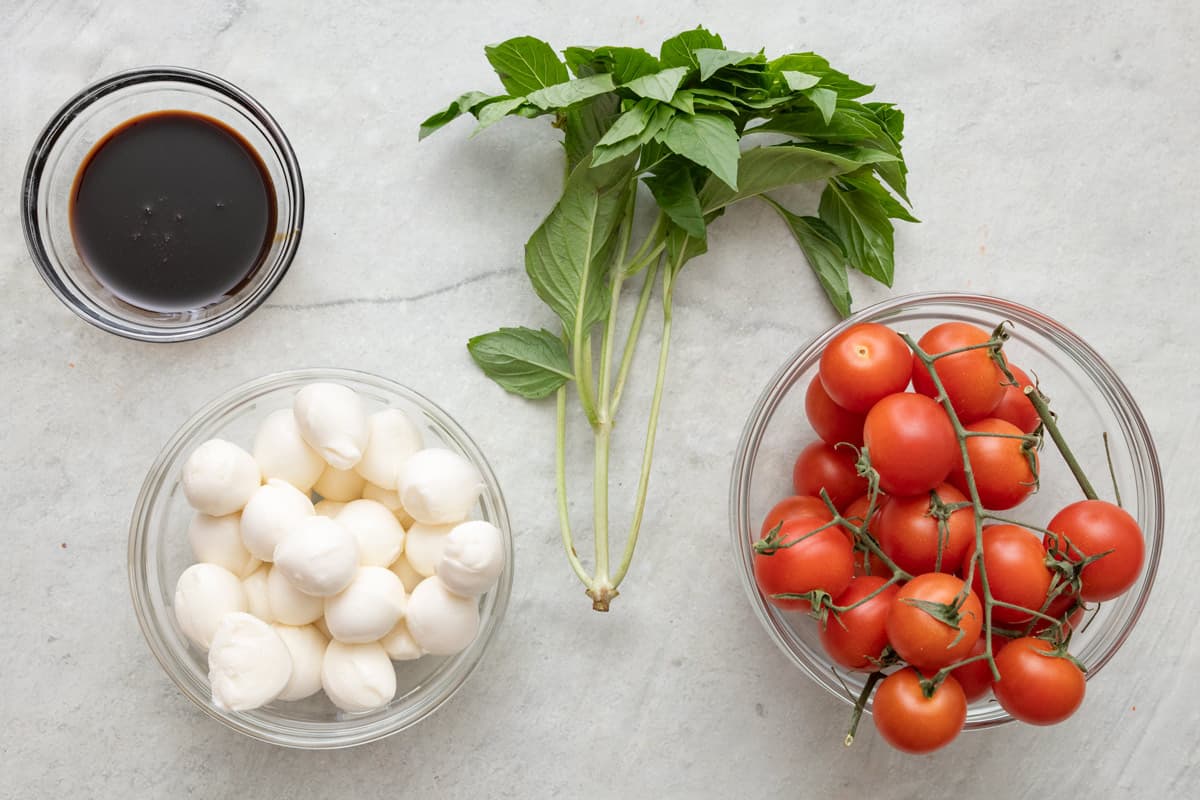Caprese Skewers
Updated May 31, 2025
Caprese skewers made with cherry tomatoes, fresh basil leaves, and mozzarella balls all strung onto a skewer. Top with a drizzle of balsamic glaze.
This post may contain affiliate links. Please read our disclosure policy.

Jump to Section
Caprese Skewers are so fun to make!

These caprese skewers are one of my favorite things to make on grilling days. They don’t need any cooking; just tomatoes, mozzarella, and basil on a stick. So, I usually set the kids up with the ingredients and let them build while I handle the grill. Everyone loves food on a stick, and these caprese skewers always disappear fast. I just drizzle a little balsamic glaze on top and call it done.
Happy Cooking!
– Yumna
Caprese Skewer Ingredients

- Cherry tomatoes: Use small fresh tomatoes such as cherry or grape tomatoes. The size needs to be similar to the mozzarella balls.
- Mozzarella balls: Fresh mozzarella ciliegine (means cherry size in Italian!) are small balls of fresh mozzarella cheese and are great for skewering on a toothpick or cocktail pick.
- Basil: Fresh basil leaves are a must. You can’t have caprese without them.
- Balsamic glaze: Sometimes I make my own balsamic glaze, and others I use store-bought!
- Salt and pepper: A light seasoning of salt and freshly ground black pepper.
Skewers to Use
For these caprese skewers, I usually use small wooden skewers with a thumb grip (also called party picks). They’re the right size for appetizers and hold the ingredients without everything sliding off. Toothpicks work sometimes, but they’re a little short and not as sturdy. You will also only want to add one tomato, basil leaf, and mozzarella ball to each toothpick. You can also use longer bamboo skewers if you want to make full-size versions for a bigger spread, just add more tomatoes and mozzarella to fill them out.
How to Make Caprese Skewers




Caprese Skewer Recipe
Ingredients
- 1 pint cherry tomatoes or grape tomatoes
- 8 ounces fresh mozzarella Ciliegine small mozzarella balls
- ¼ cup fresh basil leaves
- 2 tablespoons balsamic glaze homemade glaze recipe
- Sea salt to taste
- black pepper to taste
Instructions
- Start by threading a cherry or grape tomato onto a skewer or toothpick, followed by a mozzarella Ciliegine ball, and then a fresh basil leaf. Repeat this process until you have the desired number of skewers or until you have used up all the ingredients.
- Arrange the assembled Caprese skewers on a serving platter or plate.
- Drizzle balsamic glaze over the skewers, sprinkle salt and pepper and serve immediately.
Notes
Nutrition
Nutrition information provided is an estimate. It will vary based on cooking method and specific ingredients used.
If you try this Caprese Skewers recipe or any other recipe on Feel Good Foodie, please rate the recipe and leave a comment below! It helps others who are thinking of making the recipe.
Recipe Tips
- Use small basil leaves. They are more intense in flavor. However, if you only have large basil leaves, gently fold them in half or roll them so all ingredients are similarly sized. But be careful with basil as it bruises easily.
- Serve chilled or at room temperature. You can serve your Caprese Kabobs directly from the fridge or at room temperature. To serve at room temp, take them out of the fridge 30 minutes before serving. You can also chill an empty plate or platter in the freezer. Then transfer the skewers to the frozen plate for serving.
FAQs
Store the skewers in an airtight container or cover them tightly with plastic wrap. This helps prevent the ingredients from drying out and maintains freshness. To avoid the ingredients from becoming soggy, it’s best to store the skewers and balsamic glaze separately. Refrigerate for up to 24 hours until ready to serve.
Fresh mozzarella balls, are typically found in small tubs submerged in brine. You can usually find them displayed alongside other varieties of mozzarella cheese or in the specialty cheese section in your local grocery store.
Yes, you can assemble the skewers ahead of time for up to 24 hours and store them in the refrigerator covered until ready to serve. Wait to add the balsamic glaze, vinegar, or other garnish before serving to prevent the skewers from getting soggy.
Yes, you can create a deconstructed version of caprese skewers by adding all ingredients to a bowl instead of threading them on a skewer. Drizzle with balsamic glaze and add a serving spoon.






